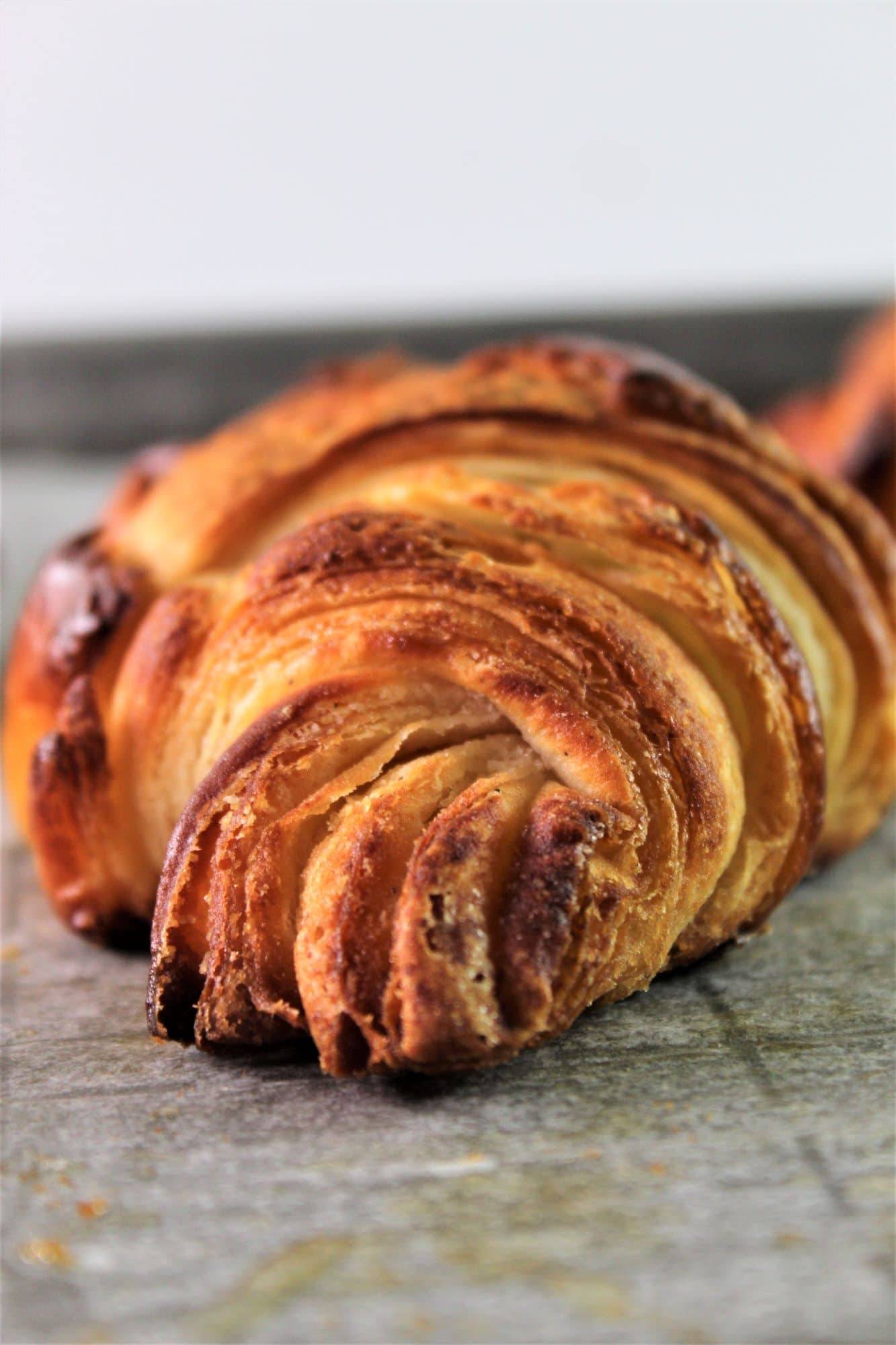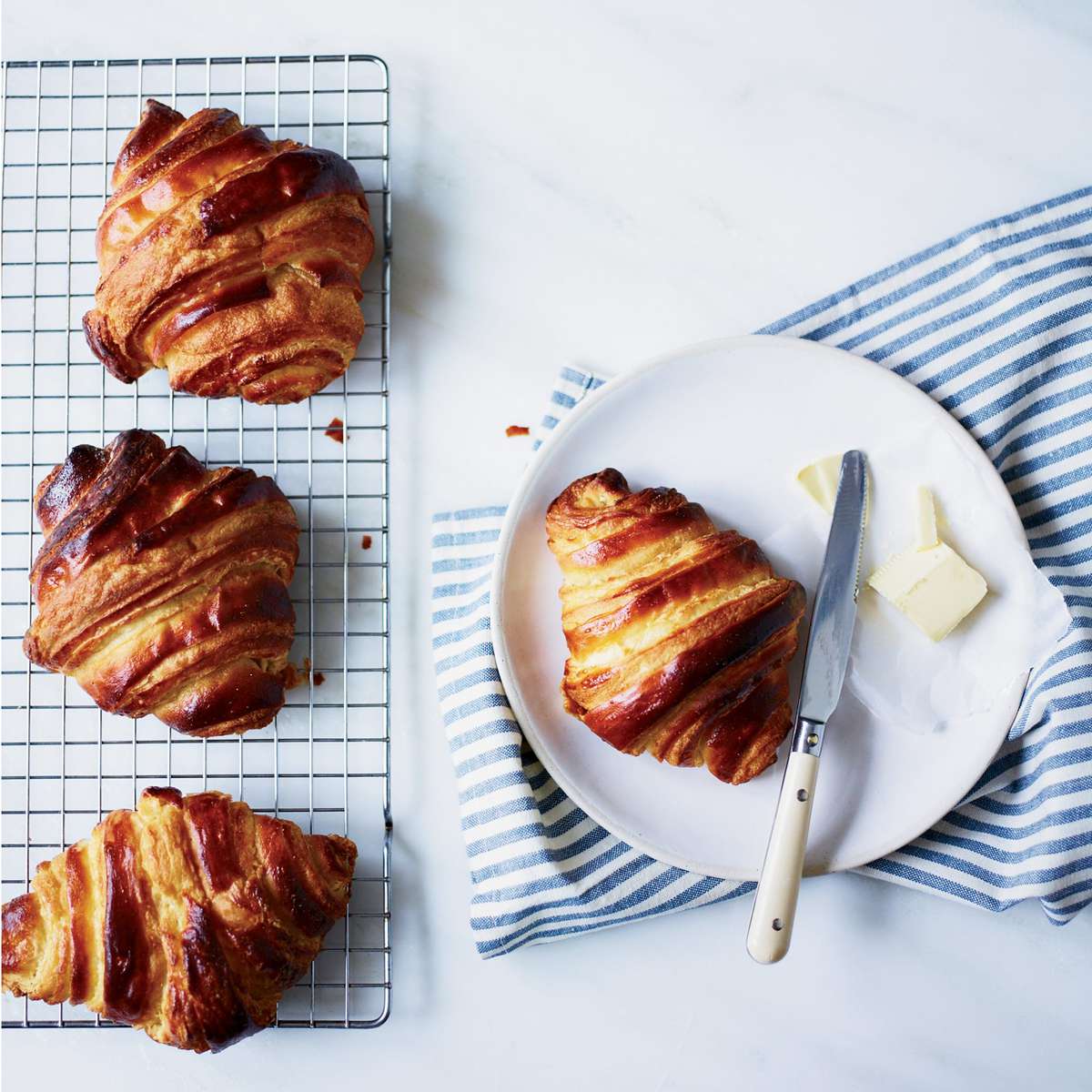Gluten-Free Croissants
5.0
(4)
Your folders
Your folders
Total: 2 hours
Servings: 6
Author : Aran Goyoaga
Ingredients
Export 13 ingredients for grocery delivery
Instructions
Step 1
This recipe is excerpted from Aran Goyoaga's forthcoming book, The Art of Gluten-Free Bread: Groundbreaking Recipes for Artisanal Breads and Pastries . Here are her recipe notes: European-style butter is best because it has a higher fat content and is much more pliable. I have tested many different vegan butters, and unfortunately not all perform the same. If you want to use vegan butter, use one that is specifically crafted for baking. Vegan butter tends to be less stable than cow’s-milk butter, which means it warms up quickly, so you might need to chill your dough in between turns. Also, since the dough doesn’t have the same elasticity, it can crack more easily when rolled. Be gentle with it. Your 2 large eggs should weigh around 110 grams. This is important because if your eggs are much larger, your dough can turn softer. Don’t be disappointed if you don’t get a perfect croissant on your first attempt. It takes a few tries to develop a sense for the consistency of the dough, how much pressure to apply when rolling, or when the dough is done proofing. Have a ruler and a very sharp paring knife nearby to help you cut even triangles and make sharp cuts to not blunt the layers.
Step 2
FOR THE DANISH DOUGH: Place 2 teaspoons active dry yeast in medium bowl. Whisk in 5 grams granulated sugar and 130 grams (105-degree) whole milk . Let mixture sit until frothy, about 10 minutes.
Step 3
In bowl of stand mixer, combine 80 grams potato starch , 70 grams sweet white rice flour , 60 grams tapioca starch , 60 grams sorghum flour , 15 grams psyllium husk powder , 1 teaspoon baking powder , 1 teaspoon xanthan gum , ½ teaspoon kosher salt , and remaining 65 grams sugar .
Step 4
Add yeast mixture to flour mixture. Attach dough hook and start mixing on medium speed. With mixer running, add 2 room-temperature eggs and continue to mix until cohesive dough forms, about 2 minutes.
Step 5
With mixer running, add 45 grams room-temperature unsalted butter 1 tablespoon at a time until dough is smooth. (Dough should feel moist but not wet—the consistency of soft pasta or Play-Doh.)
Step 6
Wrap dough in plastic wrap, flatten into rough rectangle, and refrigerate overnight or up to 24 hours.
Step 7
FOR THE BUTTER BLOCK: Lay 12 by 24-inch piece of plastic wrap on work surface. Set 225 grams room-temperature unsalted butter in middle and dust top of butter with 10 grams superfine brown rice flour . Fold plastic wrap in half lengthwise to cover butter and pound with rolling pin to flatten to about ½ inch thick.
Step 8
Uncover plastic wrap and fold butter in half. Collect any flour around butter and place on top. Cover with plastic wrap and flatten again with rolling pin. Repeat folding and flattening until butter and flour are fully incorporated.
Step 9
Shape butter block into rough 6-inch square. Wrap with plastic wrap and refrigerate until butter has hardened slightly but is still pliable, 10 minutes. (You should be able to bend butter over edge of counter without cracking. If it cracks, it’s too cold, so let it come to room temperature. If it bends and feels very soft, refrigerate another 5 to 10 minutes.)
Step 10
Remove dough from refrigerator. Unwrap and knead a few times to bring back some elasticity. (Do not let it get too warm.) Shape into rectangle.
Step 11
Lightly dust counter and rolling pin with tapioca starch and roll dough into rectangle roughly 7 by 16 inches, moving dough around so it doesn’t stick to work surface or rolling pin. Use pastry brush to brush off excess tapioca starch from dough.
Step 12
Orient dough rectangle so short side is facing you. Remove butter block from fridge. (It should be chilled but pliable.) Remove butter from plastic and place on bottom half of dough.
Step 13
Fold top half of dough over butter and pinch sides together to seal in butter. (The most important part of this step is that the dough and butter block be the same consistency and pliability so they can be folded without cracking or butter oozing out.)
Step 14
Lightly dust work surface and rolling pin with more tapioca starch . Using gentle, even pressure, roll dough into 21 by 7-inch rectangle that is ¼ inch thick.
Step 15
Using pastry brush, dust off excess starch. Fold dough into thirds. Use rolling pin, gently press down on dough so edge of folded flap on top gets lightly pressed into dough. Repeat process of dusting, rolling, and folding 2 more times for total of 3 folds. (If you are in a warm environment or you are getting used to the consistency of the dough, you can chill dough for 20 to 30 minutes between folds; otherwise you should be able to complete all 3 folds without any refrigeration.)
Step 16
After third fold, wrap dough in plastic wrap and refrigerate for 30 to 45 minutes before using.
Step 17
TO SHAPE CROISSANTS: Lightly dust work surface and rolling pin with more tapioca starch . Place dough on work surface and roll into rectangle into 13 by 12-inch rectangle that is ¼ inch thick. Trim edges of dough with very sharp knife.
Step 18
Line rimmed baking sheet with parchment paper. With long side of dough facing you, use ruler and sharp paring knife to cut dough lengthwise into 3 (4-inch-wide) rectangles. Cut each rectangle diagonally so you have 6 even triangles. Position triangles so points are facing you. Cut 1-inch notch in center of base of each triangle.
Step 19
Using your thumb and forefinger, gently pull notch away from center and roll up toward you, building curved croissant shape as you roll base of dough toward tip. Leave croissant tail hanging down without tucking it under. (Do not roll too tightly or croissants can crack when proofing and baking.) Place croissant on prepared baking sheet and repeat shaping remaining triangles.
Step 20
Wrap entire sheet pan in large plastic bag. (Alternatively, you can loosely cover pan with plastic wrap.) Let croissants rise at room temperature until they feel light and marshmallow-like to touch, 1½ to 4 hours. (You should be able to see distinct layers of dough and butter. Do not let your room temperature get over 82 degrees or butter will start to melt.)
Step 21
When croissants are done proofing, lightly whisk together 1 large room-temperature egg and 10 grams water in small bowl. Gently brush tops of croissants with egg wash, being careful not to brush exposed edges or layers. Transfer pan, uncovered, to refrigerator for 20 to 30 minutes.
Step 22
Meanwhile, adjust oven rack to middle position and preheat oven to 450 degrees. Set cast-iron pan in bottom of oven.
Step 23
TO BAKE CROISSANTS: Set baking sheet with croissants inside another rimmed baking sheet. Place croissants in oven and carefully toss 3 ice cubes into cast-iron pan in bottom of oven. Reduce oven temperature to 425 degrees and bake for 10 minutes.
Step 24
Reduce temperature to 375 degrees and continue to bake for 10 minutes longer, until croissants are deep golden-brown. (A little bit of butter oozing out is normal.)
Step 25
Transfer croissants to wire rack and cool for 5 minutes. Enjoy while warm.
Top similar recipes
Curated for youYour folders

 1130 views
1130 viewsNew and Improved Gluten Free Croiss...
letthemeatgfcake.com
4.1
(106)
20 minutes
Your folders

 321 views
321 viewsCroissants for Breakfast (Vegan, Gl...
happyasayam.com
15 minutes
Your folders
/__opt__aboutcom__coeus__resources__content_migration__serious_eats__seriouseats.com__recipes__images__2011__08__20110817-166611-flour-croissants-fb708f60c6b943588a4407033182d8a0.jpg)
 387 views
387 viewsCroissants
seriouseats.com
Your folders

 402 views
402 viewsCroissants
allrecipes.com
4.2
(136)
15 minutes
Your folders

 502 views
502 viewsCroissants
marthastewart.com
3.6
(150)
Your folders

 388 views
388 viewsCroissants
foodandwine.com
Your folders

 247 views
247 viewsCroissants
cookwithnabeela.com
5.0
(1)
20 minutes
Your folders

 439 views
439 viewsCroissants
cooking.nytimes.com
4.0
(671)
Your folders

 357 views
357 viewsCroissants
bbcgoodfood.com
18 minutes
Your folders

 212 views
212 viewsCroissants
yumelise.fr
5.0
(2)
17 minutes
Your folders
 378 views
378 viewsCroissants
yumelise.fr
Your folders

 101 views
101 viewsCroissants
getrecipecart.com
4.0
(671)
Your folders

 444 views
444 viewsHomemade Gluten Free Pasta (Gluten ...
theloopywhisk.com
5.0
(27)
5 minutes
Your folders

 265 views
265 viewsGluten Free Trifle with Gluten Free...
glutenfreeonashoestring.com
5.0
(2)
10 minutes
Your folders

 248 views
248 viewsSnickers croissants
taste.com.au
3.0
(2)
20 minutes
Your folders

 596 views
596 viewsCheese Croissants
crazyforcrust.com
15 minutes
Your folders

 523 views
523 viewsHomemade Croissants
jocooks.com
4.5
(502)
24 minutes
Your folders

 617 views
617 viewsCroissants Recipe
seriouseats.com
5.0
(2)
Your folders

 488 views
488 viewsBaker's Croissants
kingarthurbaking.com
4.6
(111)
40 minutes